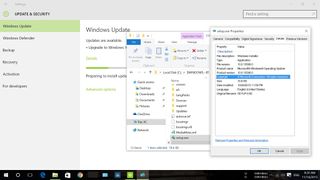What's the difference between upgrading Windows 10 using Windows Update or ISO file

On November 12th, Microsoft finally began rolling out its first major update for Windows 10 (build 10586). On the same day, the New Xbox One Experience (build 10586) was made available to everyone too, and now we're just waiting for Windows 10 Mobile, which should be arriving pretty soon.
The Windows 10 November update, or version 1511, brings a lot of changes, improvements, and features that according to the software giant make the operating system mature enough to be recommended as a daily driver for organizations.
Among the many changes, which you can learn more in our previous article, Microsoft is including performance improvements to help users perform tasks faster than in Windows 7. Cortana brings handwriting recognition and "missed call notifications" features, Microsoft Edge includes changes that make daily browsing more stable and secure, there are new and updated apps, a bunch of new features on the Settings app, and a lot more.
For those users who have been using Windows 10 since launch, this is an update they want to install. Microsoft is currently pushing the November update through Windows Update, but it seems that not everyone is getting the update just yet, and of course, there could be a few reasons for this to happen.
Reasons for no update
For starters, Microsoft has noted that systems that have been upgraded to Windows 10 for less than 31 days won't be seeing the update for a while. This approach is intentional to avoid removing the ability to roll back to the previous version for those who are still in the trial period.
Also, you probably might have deferred getting the update, which will delay the upgrade even further, or there might be a problem with Windows Update.
For whatever the reason, if you're not getting the update, and you're interested in getting it immediately, Microsoft is also offering the Windows 10 ISO files that you can download using the Media Creation Tool to make an installation media.
Get the Windows Central Newsletter
All the latest news, reviews, and guides for Windows and Xbox diehards.
Differences between ISO and WU?
Now, many users might feel that there is a difference between using Windows Update or an ISO file, but both options are virtually identical (at least for the version 1511 release). While you can use an ISO file to create an installation media to start from scratch, you can also perform an upgrade, which is exactly the process the Windows Update will go through to install version 1511.
Unlike regular updates, during the Windows 10 November update downloaded through Windows Update, a $WINDOWS.~BT folder will be created on the C drive with the installation files, which are the same files, you'll find in the ISO file.

The only difference is that using Windows Update, the process is more automated, and doing a manual upgrade will require you to go through a few choices you need to make to perform the upgrade. But the actual installation process is the same. (Don't forget that our previous article will guide you through the upgrade process using an ISO file.)
Neither using Windows Update nor an ISO file to upgrade your current version of Windows 10 will wipe your system, or delete your files or applications, and you won't be prompted to re-activate either.
However, remember that if you force the upgrade, you will lose the chance to downgrade to Windows 7 or Windows 8.1, if you still had a few days left in the trial period. If things aren't working correctly, the November update will also create a Windows.old folder with your previous installation that will allow you to go back as necessary using the Recovery feature in Windows 10 -- either if you used Windows Update or an ISO file.
How are you installing the Windows 10 November update? Let us know in the comments below.
Mauro Huculak has been a Windows How-To Expert contributor for WindowsCentral.com for nearly a decade and has over 15 years of experience writing comprehensive guides. He also has an IT background and has achieved different professional certifications from Microsoft, Cisco, VMware, and CompTIA. He has been recognized as a Microsoft MVP for many years.
